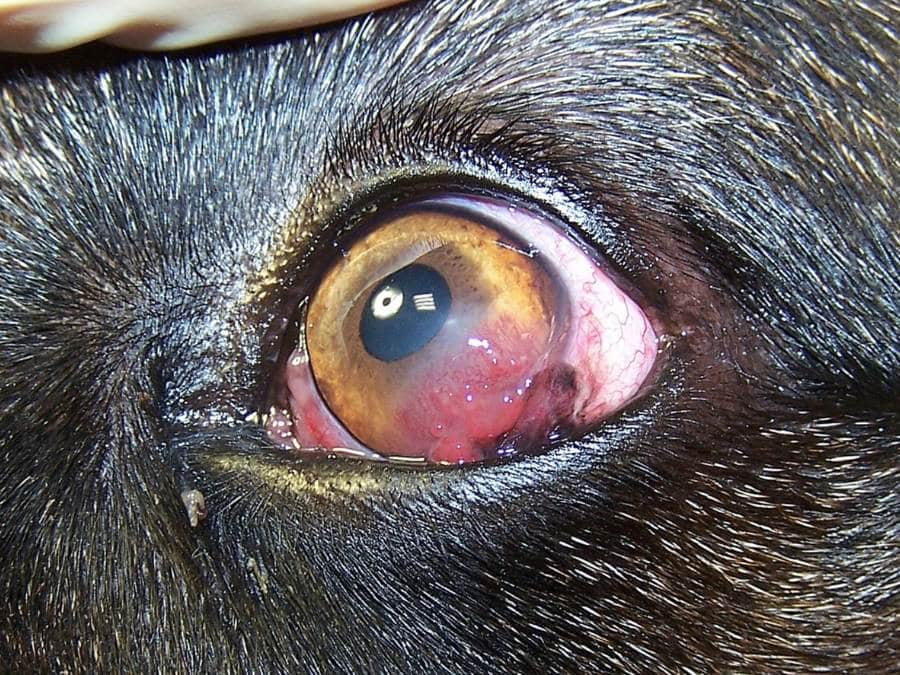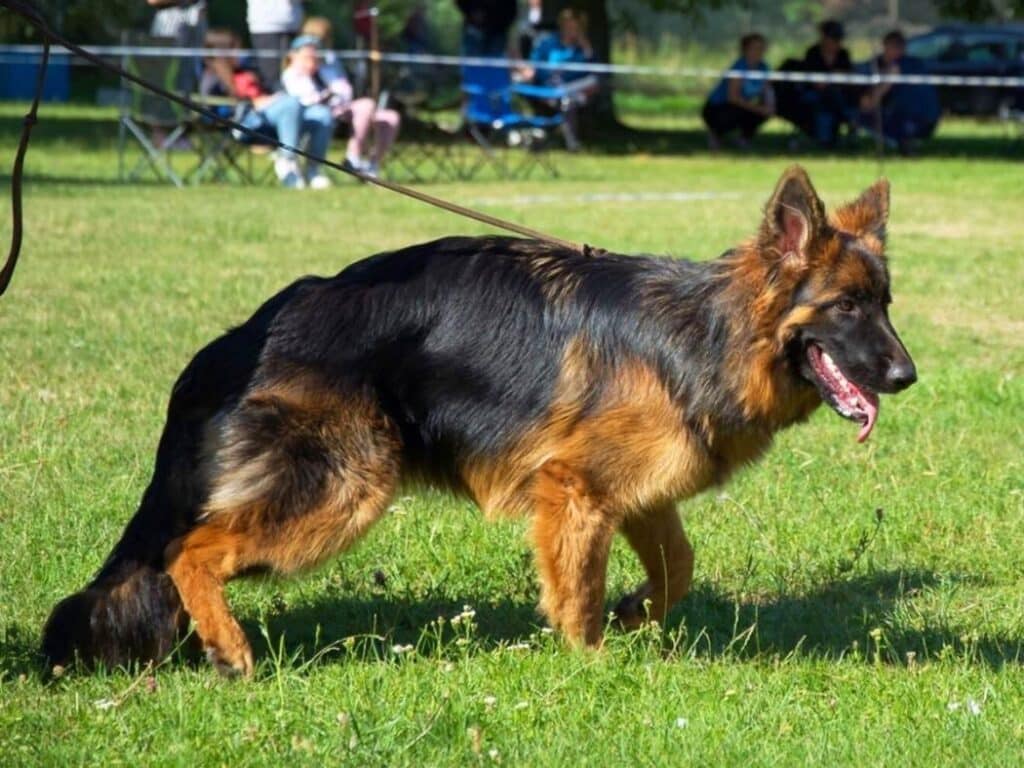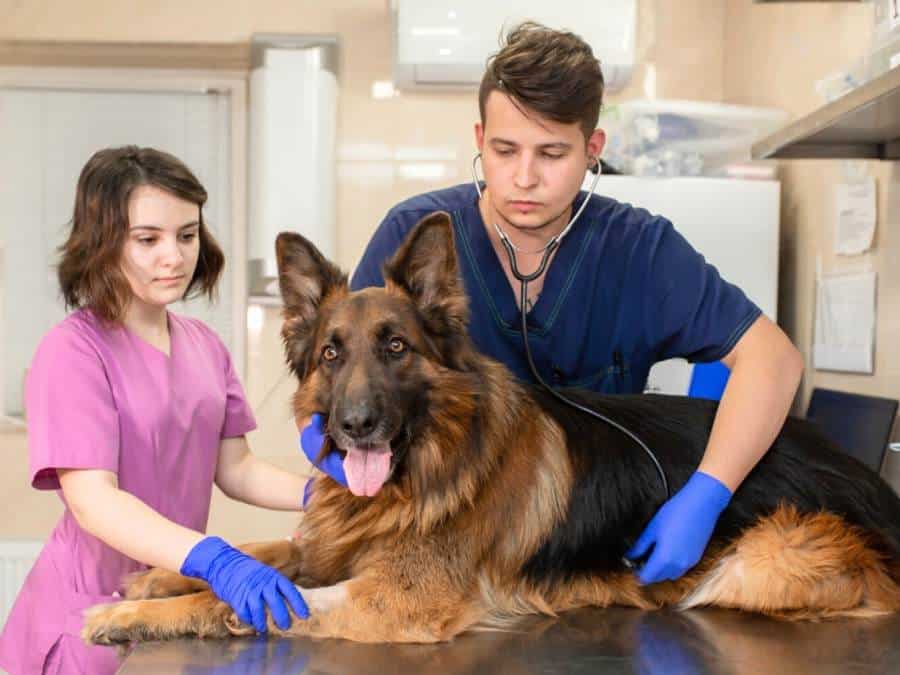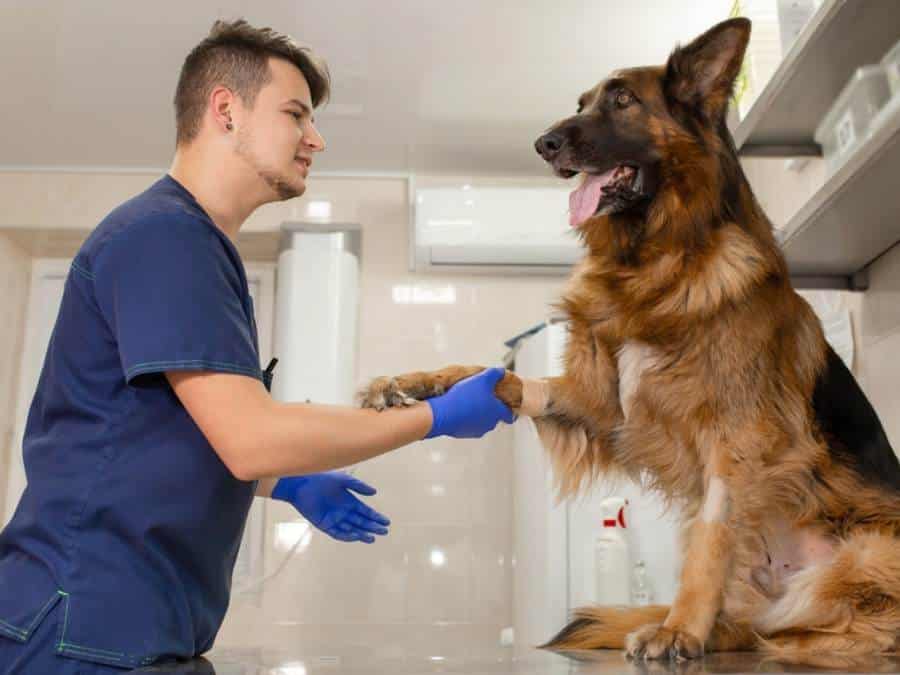German Shepherds are unfortunately genetically predisposed to pannus, however, other breeds may also be affected. Pannus, also known as Chronic Superficial Keratitis (CSK), is a progressive, immune-mediated disease affecting the dog’s cornea and sometimes the third eyelid of dogs. This condition can lead to significant visual impairment and, in severe cases, blindness if not properly managed.
Recognizing the early signs of pannus and understanding the treatment options can make a significant difference in the outcome for affected dogs.
In this comprehensive guide, we’ll explore what pannus is, its causes, symptoms, diagnostic processes, treatment options, and the prognosis for German Shepherds living with this condition.
What is Pannus in German Shepherds?
Pannus, or Chronic Superficial Keratitis (CSK), is an autoimmune disease characterized by an inflammatory process that affects the cornea—the clear outer layer at the front of the eye.
It causes parts of the GSD’s eyes to become cloudy, hazy, or pigmented over time, and often affects both eyes.
Progression of this disease leads to the development of granulation tissue that can severely impair vision.

Pannus is most commonly seen in middle-aged to older German Shepherds, and while it can affect any breed, certain breeds including GSD mixes, Siberian husky, Border Collies, and Greyhounds are at a higher risk.
How fast does pannus progress?
The progression of pannus can be slow or rapid, with varying degrees of severity. Without treatment, the increasing opacity, pigmentation, and vascularization (growth of new blood vessels) of the cornea can significantly hinder a dog’s ability to see.
What Causes Pannus in German Shepherds?
Pannus is a complex disease with no singular cause. Instead, it is the result of a combination of genetic predisposition, environmental factors, and the immune system’s abnormal response.
Understanding these factors can help in managing the disease more effectively.
Genetic Predisposition
Research and clinical evidence suggest a strong genetic component to pannus.
Certain breeds, such as German Shepherds, Greyhounds, and Border Collies, show a higher prevalence of the disease, indicating that heredity plays a significant role.
This predisposition does not guarantee that every dog of these breeds will develop pannus, but it does mean that they are at a higher risk compared to other breeds.
Environmental Factors
Environmental exposure has been identified as a key factor in the development and progression of pannus.
High altitudes and increased exposure to ultraviolet (UV) light are known to exacerbate the condition. (Source)
Dogs living in areas with strong sunlight and those who spend a lot of time outdoors without eye protection may have an increased risk of developing pannus.
Immune System’s Role
At its core, pannus is an autoimmune disease, where the dog’s immune system mistakenly identifies the corneal tissue as foreign and initiates an inflammatory response against it.
This response leads to the characteristic changes seen in the cornea, including pigmentation, vascularization, and thickening.
The exact trigger for this autoimmune response is not fully understood, but it’s believed to involve a complex interaction between genetic factors and environmental triggers.

What are the Symptoms of Pannus in German Shepherds?
Recognizing the symptoms of pannus early can be critical for a favorable outcome. Symptoms often start subtly and progress over time. Both eyes are usually affected, but one may appear worse than the other.
- Cloudiness or Opacity: One of the earliest and most noticeable signs is a cloudiness or opaque appearance that develops over the cornea. This is due to the growth of lesions on the cornea and the third eyelid.
- Pinkish-Red Tissue Growth: You may notice a fleshy, pinkish-red growth or lesions on the cornea, which can start at the corner of the eye and spread across the surface if untreated. The lesions most commonly emerge near the lower-inner part of the eye (ventral-nasal), the lower-outer part of the eye (ventral-temporal), or at the side of the eye (temporal limbus).
- Pigmentation: As the condition progresses, you may observe pigmentation on the cornea. The pigmentation can range from light to dark and may increase over time, potentially leading to a significant reduction in vision.
- Redness: The eyes may appear red and irritated due to inflammation. This can be particularly evident in the conjunctiva and around the edges of the cornea where the abnormal tissue growth begins.
- Discomfort or Pain: Dogs with pannus may exhibit signs of discomfort or pain, such as squinting, blinking excessively, or rubbing their eyes against objects or with their paws.
- Tearing or Discharge: Increased tearing or the presence of discharge from the eyes can occur, although this symptom is more variable.
- Sensitivity to Light: Dogs with pannus may become increasingly sensitive to light and may squint in bright conditions.
- Vision Impairment: Over time, as the disease progresses and the cornea becomes increasingly covered by tissue and pigmented, the dog’s vision may be affected. This may not be immediately obvious but can be inferred from changes in behavior, such as hesitance to navigate in familiar environments, bumping into objects, or reluctance to go from bright to dimly lit areas or vice versa.
Early detection and treatment can significantly slow the progression of these symptoms and help maintain the dog’s quality of life.
RELATED: Why Does My German Shepherd Have Red Eyes?

How is Pannus Diagnosed in German Shepherds?
Diagnosing pannus involves a combination of clinical examination and diagnostic tests to rule out other eye conditions with similar symptoms. Early and accurate diagnosis is key to managing the disease effectively and preserving the German Shepherd’s vision.
Clinical Examination
The process begins with a thorough clinical examination by a veterinarian, ideally one with experience in ophthalmology.
During the examination, the vet will look for the characteristic signs of pannus, such as pigmentation, vascularization, and thickening of the cornea.
The vet will also assess the eye’s overall health, including the third eyelid, which can be affected in some cases of pannus.
Diagnostic Tests
Several diagnostic tests can help confirm the diagnosis of pannus and rule out other conditions:
- Schirmer Tear Test: This test measures tear production to rule out dry eye (keratoconjunctivitis sicca), which can mimic some symptoms of pannus.
- Fluorescein Stain: This test involves applying a dye to the eye, which helps highlight any corneal ulcers or injuries that could be mistaken for or contribute to pannus.
- Biopsy: In rare cases, a biopsy of the affected tissue may be performed to confirm the diagnosis, especially if the response to initial treatment is not as expected.
Differential Diagnosis
It’s important to differentiate pannus from other eye conditions that can present with similar symptoms, such as infections, injuries, or other immune-mediated diseases.
A thorough diagnostic process ensures that the treatment plan is tailored to the specific needs of the German Shepherd with pannus.
RELATED: Common German Shepherd Eye Problems

German Shepherd Pannus Treatment Options
While pannus is a chronic condition that cannot be cured, it can be managed effectively with ongoing treatment.
The goal of treatment is to reduce inflammation, slow the progression of the disease, and preserve the dog’s vision as much as possible.
Medical Treatments
- Topical Corticosteroids: These are the mainstay of pannus treatment and are effective in reducing inflammation. They must be applied regularly and usually for the life of the dog. (Source)
- Immunosuppressive Drugs: For more severe cases or those not responding well to corticosteroids, immunosuppressive medications may be used to control the immune system’s attack on the cornea.
- Cyclosporine or Tacrolimus: These topical medications are alternatives or adjuncts to corticosteroids and work by specifically targeting the immune response in the eye.
- Newer treatment methods now include the administration of long-lasting cyclosporin implants through subconjunctival injection.
Surgical Options
Surgery is rarely needed in cases of pannus but may be considered if there is severe scarring or to remove excessive tissue growth. However, medical management is the preferred and most common treatment approach.
UV Protection
Protecting the eyes from UV light is crucial in managing pannus. Dog sunglasses or protective eyewear designed for dogs can be very effective, especially for dogs living in high-altitude areas or those exposed to intense sunlight.
Lifestyle Adjustments
In addition to medical treatment, lifestyle adjustments can help manage pannus. These include limiting exposure to environmental factors that can worsen the condition and regular monitoring by a veterinarian to adjust treatment as needed.
RELATED: German Shepherd Eye Discharge
What is the Prognosis for German Shepherds with Pannus?
The prognosis for German Shepherds with pannus is generally good, provided that the condition is diagnosed early and treatment is started promptly.
With ongoing management, most dogs maintain a good quality of life and vision. Regular follow-up visits with a veterinarian are essential to monitor the condition and adjust treatment as necessary.
German Shepherd owners need to understand that pannus is a lifelong condition that will require continuous care. However, with the right approach, most dogs can live relatively normal lives.
RELATED: German Shepherd Eye Infection

Natural Remedies for Pannus in German Shepherds
While the primary treatment for pannus in German Shepherds involves medical interventions prescribed by a veterinarian, including corticosteroids and immunosuppressive medications, some pet owners also seek natural or supportive treatments to complement these therapies.
It’s crucial to emphasize that natural treatments should not replace conventional veterinary care but can be used alongside it to support the overall health and well-being of a dog with pannus.
Always consult with a veterinarian before starting any new treatment, natural or otherwise, to ensure it’s safe and suitable for your dog’s specific condition.
Here are some natural approaches that may support the treatment of pannus in German Shepherds:
Dietary Supplements
- Omega-3 Fatty Acids: Found in fish oil, these fatty acids are known for their anti-inflammatory properties and may help reduce overall inflammation in the body, including the eyes. (Source)
- Vitamin E: An antioxidant that can help support eye health and combat oxidative stress, which contributes to inflammation.
- Vitamin C: Another antioxidant that supports the immune system and may help reduce corneal inflammation.
Protective Measures
- UV Eye Protection: Protecting your German Shepherd’s eyes from UV light is crucial in managing pannus. Consider using protective eyewear designed for dogs, such as dog goggles, when spending time outdoors, especially in high-altitude areas or places with strong sunlight.
- Environmental Modifications: Reducing exposure to environmental irritants, such as dust, smoke, and chemical fumes, can help minimize eye irritation and inflammation.
Herbal Remedies
Some herbal remedies are believed to support eye health and reduce inflammation.
However, the effectiveness and safety of these remedies for dogs with pannus have not been widely studied, so proceed with caution and consult a veterinarian experienced in herbal medicine.
Potential herbs that may offer support include:
- Turmeric: Contains curcumin, known for its anti-inflammatory properties.
- Bilberry: Often used to support eye health due to its antioxidant properties.
- Eyebright: Traditionally used for eye irritations and conditions due to its anti-inflammatory and astringent properties.
Lifestyle Adjustments
- Regular Exercise: Maintaining a healthy weight and overall physical health can support the immune system and potentially reduce the severity of autoimmune responses.
- Stress Reduction: Minimizing stress through a stable routine, regular exercise, and a calm environment may help support the immune system.
It’s important to reiterate that natural treatments should complement, not replace, the treatment plan prescribed by your veterinarian.
Always discuss any natural remedies or supplements with your veterinarian to ensure they are safe for your dog and to avoid any potential interactions with prescribed medications.
Final Remarks
Pannus underscores the importance of regular veterinary check-ups and eye examinations, especially for German Shepherd dogs who are genetically predisposed to this disease. With the right approach to treatment and management, including protecting the eyes from UV light and adhering to prescribed therapies, dogs with pannus can continue to lead happy, fulfilling lives.
Frequently Asked Questions
1. Is Pannus in German Shepherds Contagious?
No, pannus in dogs is not contagious. It is an autoimmune condition where the dog’s immune system attacks the cornea of the eye, leading to inflammation and tissue growth. This disease does not spread from one dog to another or to humans.
2. Is Pannus in German Shepherds Hereditary?
Yes, pannus in German Shepherds is believed to have a hereditary component. Certain breeds, such as Greyhounds, Border Collies, and GSDs are more predisposed to developing the condition, indicating a genetic predisposition.
3. Is Pannus in German Shepherds Painful?
Pannus itself is not typically painful for dogs. However, the condition can lead to discomfort due to secondary symptoms such as redness, irritation, and potential vision impairment. Dogs may exhibit signs of discomfort, such as squinting or rubbing their eyes, especially in bright light or when the condition progresses without treatment.
4. Can Pannus in German Shepherds Be Cured?
Currently, there is no cure for pannus in dogs. The condition is chronic and requires lifelong management to control the symptoms and slow the progression of the disease. Treatment plans often include medications to reduce inflammation and immune system activity, along with protective measures to shield the eyes from UV light.
5. What Does Pannus in German Shepherds Look Like?
Pannus in German Shepherds typically appears as a gray, pink, or reddish film that develops over the cornea. The affected area may also exhibit pigmentation and vascularization (formation of new blood vessels), leading to a cloudy or thickened appearance of the eye. Lesions can be more pronounced near the lower part of the eye or at the edges (limbus).
6. How Fast Does Pannus Progress in German Shepherds?
The progression of pannus in dogs can vary widely among individuals. In some dogs, the condition progresses slowly over several years, while in others, it may advance more quickly, leading to significant vision impairment within a few months.
Factors influencing the rate of progression include the effectiveness of the treatment plan, the dog’s overall health, and exposure to environmental factors such as UV light.
7. What Age Do German Shepherds Get Pannus?
Pannus typically affects middle-aged to older German Shepherds, usually starting around the ages of 5 to 8 years. However, it can also occur in younger or older dogs in some cases.
FURTHER READING:




